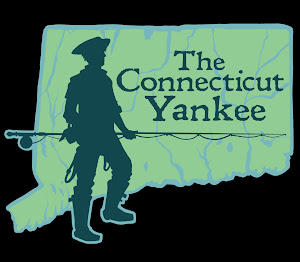There was no sign of them only a
week earlier, so I was both surprised and delighted to see tiny rings scattered
across the glassy surface of the reservoir. What looked like a passing rain
shower was actually baitfish schooling at the top of the water column. Sunday breakfast
was served and soon followed the first boil that cut through the morning
silence.
Anadromous alewives
have been running our tidal rivers each spring since the last glaciers
retreated, but it wasn’t until around 1990 that the landlocked variety were introduced
in Connecticut. Since then, in a number of waterbodies around the state, this
member of the herring family has become a favorite forage for larger predators like
trout, walleye, bass, and almost anything big enough to eat them. And where
populations of landlocked alewives are present, there is usually opportunity to
catch special fish.
On this morning I had set out while
still dark with high hopes for walleye. I was fishing two slip bobber rigs with
bobber stops set so my shiners dangled just over where I thought bottom was. The
first bobber went under as the sun started creeping over the tree line. To my
surprise it was a black crappie; not a large one nor the species I was after,
but I was happy to rid the skunk. While I’m no expert in the calico bass
department, I do know where there’s one, there’s usually more.
All this time alewives were still
dimpling on the surface. After a few more boils from what I assumed were trout,
a good enough case had been made to ditch the walleye plan and bring my baits
up higher. I made one more cast before adjusting
and, as luck would have it, my rig got fouled around my slip bobber and the
shiner began flailing on the surface when it hit the water. The struggling prey
was too enticing and something engulfed it almost immediately, crashing on it
like a striper would a pencil popper. I set the hook and reeled in a respectable
brown trout—my first from this reservoir in years. Without that tangle, I
wasn’t catching that trout—sometimes it’s better to be lucky than good.
There was a time when most brown
trout caught in this reservoir were seeforellens. DEEP brought the German strain
to Connecticut in the early 90s and they thrived in a handful of our deep lakes
with high populations of alewives. It was a real gut punch in 2016
when seeforellen production was cut from our hatchery system due to cost-saving
measures, but not before the strain made a lasting impact
with Connecticut’s brown trout record changing hands twice between 2011 and 2014.
There are undoubtedly some giant
pre-2016 “seefs” still lurking in our waters, and thankfully it looks like the
days of rearing this strain in Connecticut are returning. According to the
state’s latest salmonoid
action plan, the Fisheries Division is “currently re-establishing a broodline
of the seeforellen brown trout strain” at the at the Kensington State Fish
Hatchery, which is welcomed news to this angler.
After releasing the trout, I
adjusted the two slip bobber rigs to suspend my shiners about five and six feet
below the surface. There was a light breeze that created a left-to-right drift and
took my bait from deep water over a shallow shelf. Just like you’d expect them
to be, the fish seemed to be straddling this drop-off and that’s where my
bobber went down four different times, but it was the final two that are going
to stick with me for a while.
A little after 7 a.m. the fish
gods made it clear that it wasn’t walleye or trout that I was supposed to catch
that day. The next bobber take-down resulted in another black crappie, but this
one was an absolute unit. It taped out to 15.25-inches, my largest calico ever,
and had a full belly on it. The shiner was halfway down its gullet and this fish
was unquestionably suspended over the shallow structure, pigging out on the schooling
alewives. While crappie are considered excellent table fare, this specimen had
me in awe and I decided to let it go.
Over the next hour I tried tapping into what I assumed was a good school of crappie in front of me. Along with drifting live bait, I peppered the area with artificials—hair jigs, plastic tubes, blade baits—but nothing. Then, with only minutes before my cut-off time, another bobber down by another giant calico—a near carbon copy of the previous one, if not a touch heavier. Just an incredible specimen that I couldn’t bear to harvest. I released the fish, packed my gear and left them biting, but it was a hell of way to go out.
What happened in those two hours was not lost on me—originally out for walleye, then changing it up for trout, only to stumble upon the two best crappie of my life. It was an eventful morning that did wonders in boosting my appreciation for the species. It also reminded me that no matter how much I want to stick to a specific game plan, often times it pays to observe what’s happening and just go with the flow (or just get lucky). Two of the three alewife-stuffed calico bass I caught would have qualified for DEEP’s trophy fish award program had I done the proper documentation, but I’m content with the memory and that their genes are still in the gene pool.














































No comments:
Post a Comment